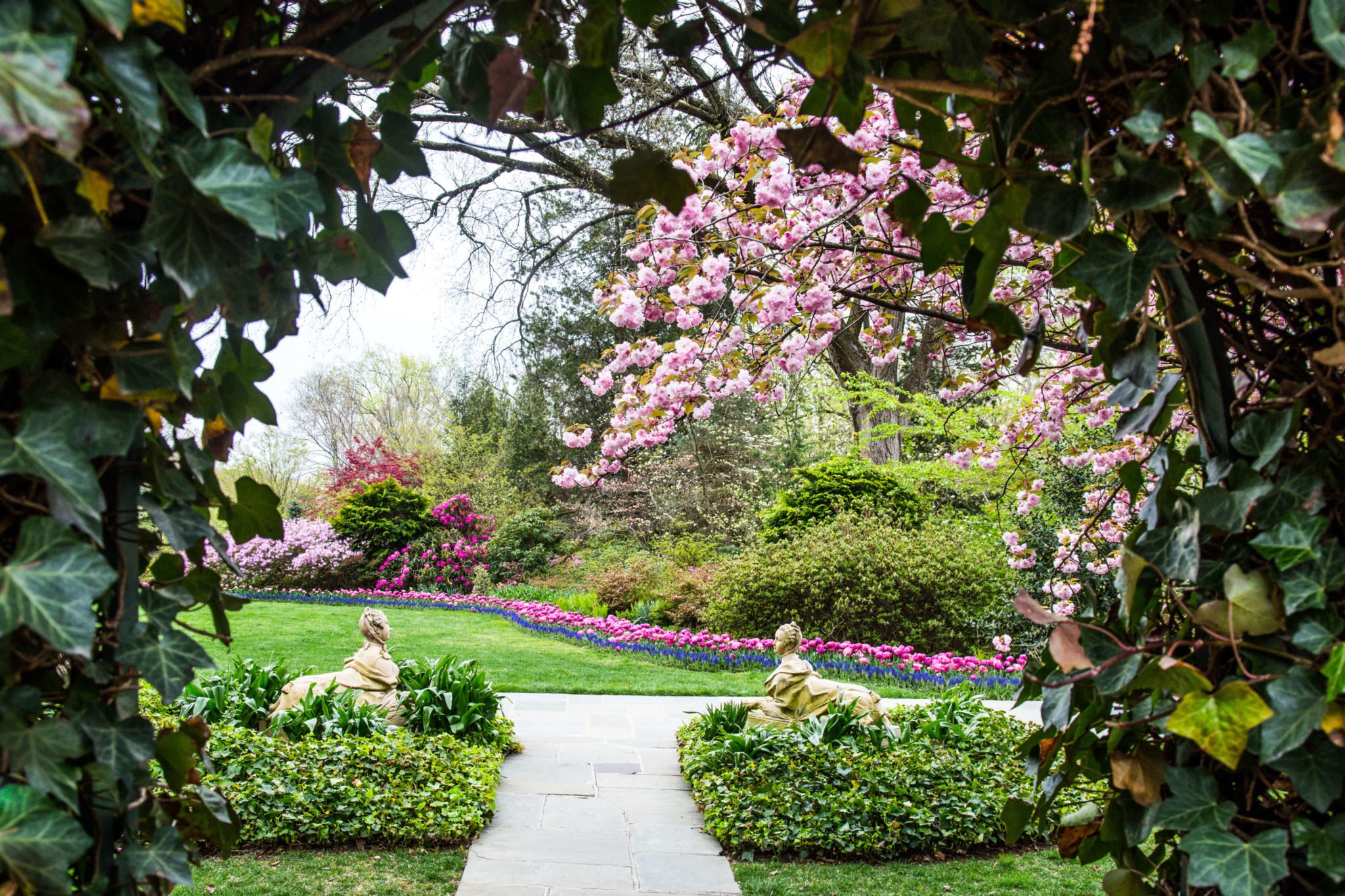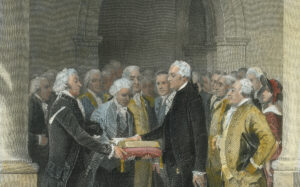In addition to historic monuments, moonlit tours, great walking and hiking trails, and many parks, there are other outdoor destinations in DC that you can visit when you don’t want to be indoors. From recommended garden tours to the city’s beloved zoo, here are ten outdoor attractions to consider adding to your itinerary.
Arlington National Cemetery
Some 400,000 people are buried in the 639 acres of America’s most famous cemetery, including President John F. Kennedy and Jacqueline Kennedy Onassis; Pierre L’Enfant, the architect of Washington; boxer Joe Louis; author Dashiell Hammett; and former chief justice William Rehnquist.
877-907-8585; arlingtoncemetery.mil. Metro station: Arlington Cemetery. Free.
Dumbarton Oaks
A historic home with expansive gardens that’s part museum, part library, part event venue, part research institute (owned by Harvard University), Dumbarton Oaks in Georgetown focuses its programming and resources on three specific areas of interest: Byzantine, Pre-Columbian, and garden and landscape studies—including its specialized collections of Byzantine and Pre-Columbian art.
1703 32nd St., NW; doaks.org. Metro station: To access Dumbarton Oaks via metro, visitors could take a bus from either the Dupont Circle or Foggy Bottom-GWU metro stations. Admission to the museum and rare book library is free; tickets to the gardens are $15.
Frederick Douglass National Historic Site
Visitors can access Frederick Douglass’s home at Cedar Hill, where the abolitionist and orator spent his last 17 years, with guided tours, which are offered up to nine times a day. Beyond the residence, a 19-minute film called “Fighter for Freedom: The Frederick Douglass Story” plays in the visitor’s center auditorium, and the grounds feature a garden, trees that date back to Douglass’s days at the property, and a small brick building called a “Growler.”
1411 W St., SE; 771-208-1499; nps.gov/frdo. Visitors can take a bus the 3/4 of a mile from the Anacostia station to the site. Free.
Hillwood Estate, Museum, & Gardens
Founded by Marjorie Merriweather Post, the Hillwood Estate & Gardens is a home-turned-museum known for a collection that includes impressive Fabergé eggs, but one of its big draws is the property’s 13 acres of perfect manicured, formal gardens.
4155 Linnean Ave., NW; 202-686-5807; hillwoodmuseum.org. Metro station: Hillwood is a mile-long walk from the Van Ness/UDC station.
Kenilworth Park & Aquatic Gardens
The Kenilworth Aquatic Gardens are home to birding and other wildlife viewing, walking trails, and—its main attraction—water gardens, including ponds filled with 500-year-old lotus and tropical lilies.
1550 Anacostia Ave., NE; 771-208-1571; nps.gov/keaq/index.htm. Metro station: Deanwood. Free.
National Zoo
Set on 163 acres in Northwest Washington, the National Zoo was founded in 1889 to inspire the “advancement of science, the instruction and recreation of the people.” Since the 1960s, the zoo has worked toward conserving and breeding endangered species; its 3,200-acre complex in Front Royal, Virginia, serves as the headquarters for the Smithsonian Conservation Biology Institute.
The zoo’s DC space is home to about 2,000 animals of 400 different species, the stars of which are undoubtedly the giant pandas, Bao Li and Qing Bao, who arrived here on loan from China in January 2025. The panda exhibit leads into the Asia Trail, which includes clouded leopards, red pandas, sloth bears, and fishing cats. The zoo’s comprehensive Asian Elephants exhibit currently houses six elephants, but is large enough to house up to ten.
The park also includes a Reptile Discovery Center with turtles, snakes, alligators, Komodo dragons, and more; a recently renovated and reopened Bird House with more than 170 individual birds representing 56 species; a Great Cats exhibit with Sumatran tigers and African lions; a Great Ape House; and several other exhibits. Don’t miss Amazonia, a 15,000-square-foot rainforest exhibit with a 55,000-gallon aquarium and more than 350 species of tropical plants.
3001 Connecticut Ave., NW; 202-673-4888; nationalzoo.si.edu. Metro station: Woodley Park-Zoo/Cleveland Park. Free; entry passes required.
Tudor Place Historic House & Garden
A federal-style mansion on five and a half acres in Georgetown, Tudor Place “preserves the stories of six generations of descendants of Martha Washington and the enslaved and free people who lived and worked” there for nearly two centuries. It’s home to more than 18,000 decorative objects and mementos, including a collection the family purchased as part of an estate sale from Mount Vernon.
1644 31st St., NW, 202-965-0400; tudorplace.org. Metro station: Visitors can take a bus from the Dupont Circle, Foggy Bottom, or Rosslyn metro stations. $10 for adults; $5 for students, seniors, and military; free for members and children under 5.
United States Botanic Garden
Another indoor/outdoor spot, this giant “national greenhouse” on the Mall was initially conceived in 1816, and opened to the public in 1850. One of the oldest botanic gardens in the country and set on three acres, the gardens consist of three parts: a conservatory containing more than 44,000 plants, the National Garden outside, and Bartholdi Park across the street. Built in 1933, the conservatory features almost 30,000 square feet of space and includes an orchid court, a desert garden, a children’s garden with activities, and an oversize jungle area in the center with a viewing balcony from which to observe the tropical plants and vines.
The National Garden includes a rose garden and an amphitheater made from the marble steps of the Capitol’s old east portico, a butterfly garden, and a water garden dedicated to the First Ladies of the United States, while Bartholdi Park has a spectacular, recently restored fountain as its centerpiece.
100 Maryland Ave., SW; 202-225-8333; usbg.gov. Metro station: Capitol South/Federal Center. Free.
United States National Arboretum
Visitors can bike, walk, or drive through the National Arboretum’s 446 acres to see dogwood and magnolia collections, stroll through a grove of state trees, and check out the National Bonsai & Penjing Museum, which keeps its own, shorter hours. As at the Botanic Garden, remnants of the Capitol’s old east portico can be found here; marble columns stand among a reflecting pool near the center of the grounds. The arboretum is especially well known for its magnificent collection of azaleas, which typically bloom between April and May. The collection was threatened by a lack of funding in 2010 but was saved by an anonymous donation of $1 million. The Perennial Collection includes flowering peonies, daylilies, daffodils, and more; the National Herb Garden is home to holly, juniper, pansies, and over 100 varieties of roses.
3501 New York Ave., NE; 202-245-2726; usna.usda.gov. Not Metro accessible. Free.
Washington National Cathedral
The nation’s second-largest cathedral has hosted the funerals of presidents and Washington VIPs. There are multiple services daily, but the cathedral also hosts concerts, organ recitals, lectures, and tours of its magnificent Gothic architectural elements, including stained-glass windows, carvings and metalwork, and a grotesque of Darth Vader on the northwest tower. Special reservation-only Tower Climbs are a rigorous trek, but offer spectacular views of the city. While this is an indoor/outdoor destination, the grounds alone—including the Bishop’s Garden and Olmsted Woods—make it worth inclusion on this list.
Massachusetts and Wisconsin aves., NW; 202-537-6200; cathedral.org. Visitors can take a bus from the Tenleytown or Cleveland Park metro stations. Indoor tours start at $50; walking the outdoor gardens and grounds is free.


